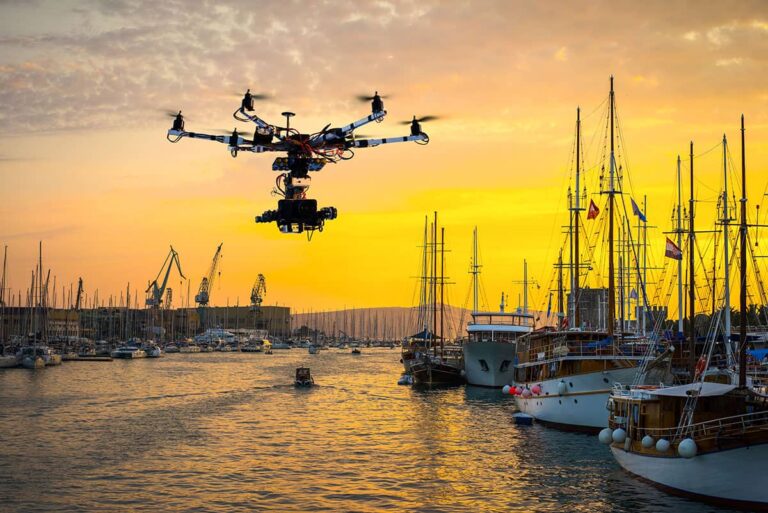What ion propulsion could mean for the drone industry
In February, University of Miami Ph.D. student, Tomas Pribanic, developed a way to apply ion thrust to autonomous aerial vehicles in the earth’s atmosphere, the school announced.
What’s that mean, exactly? It could mean wider acceptance of delivery drones via a silent ion propulsion system.
Let’s break it down a bit.
How it all works
Most VTOL (vertical takeoff and landing) drones rely on high-speed rotors to generate enough thrust to take off and stay in the air.
Meanwhile, ion propulsion is a technique for creating thrust through electrical energy … without any moving parts.
It relies on the concept of “ionic wind.”
This electro aerodynamic thrust, which is a wind or thrust, can be produced when an electric current passes between a thin and a thick electrode. With enough voltage applied, the air between the electrodes produces enough thrust to propel a small aircraft.
Currently, ion propulsion is already used to keep communication satellites properly oriented, and to propel deep-space probes.
This technology propels faster, and for greater distances. It’s also less expensive than any other propulsion technology currently available.
However, ion thrusters only provide 0.5 newtons of thrust – approximately the force you’d feel by holding ten U.S. quarters in your hand.
As a result of, these thrusters only worked, traditionally, in a vacuum, such as outer space. On Earth, much larger amounts of thrust are needed to overcome both gravity and the atmosphere.
But most drones don’t fly in a vacuum
And, that’s exactly the issue that Pribanic and other researchers are trying to address.
Back in 2018, a team of researchers at MIT built and flew the first-ever ion-propelled plane.
The plane resembled a lightweight glider with a 5-meter wingspan, weighing about 5 pounds.
It carried an array of thin and thick wires, strung like horizontal fencing both along and beneath the plane’s wings. These wires acted as positively and negatively charged electrodes that generated the thrust needed to propel the plane.
The plane was a far cry from most fuel-propelled aircraft. In fact, it was barely able to get off the ground, cruising in tests at an altitude of just 1.5 feet.
Similarly, UC Berkeley researchers built an ion-propelled drone the size of a penny.
Now, Pribanic and his company, Undefined Technologies, claimed that they increased the thrust of ion propulsion systems to “unprecedented levels” with its “Air Tantrum” technology.
They have released a video of their ion-propelled prototype and announced their aim to transform drone deliveries.
With this technology, they hope to create a silent drone capable of carrying out deliveries without generating noise pollution in residential areas.
How could this impact the drone industry?
If ion propulsion is made viable for aircraft operating in the earth’s atmosphere, it would be a game-changer for the drone industry.
Noise pollution, along with violation of privacy, serves as one of the public’s biggest concerns in regard to commercial drone use and, in particular, drone deliveries.
A 2017 NASA study found that buzzing drones annoy people more than rumbling cars and trucks. Similarly, irritation with the noise of Alphabet Wing’s drones was one of the biggest reasons that its rollout met notable opposition from concerned residents in both the U.S. and Australia.
In theory, if ion propulsion solves the noise problem, it may improve public approval for drone deliveries, enabling the likes of Alphabet, Amazon, and Walmart to expand their delivery programs.
So, will we be seeing ion-propelled drones any time soon?
While Pribanic’s work is impressive, ion propulsion is just one way to make drones quieter.
But, will it actually solve the noise problem?
Each ion-propelled prototype created so far has been extremely lightweight. Due to their tiny batteries, they’re only suitable only for short, cargo-less flights.
For drone delivery usage, these drones require more battery resources, navigation sensors, cargo, and other various instruments.
Even with an extremely lightweight (and potentially fragile) frame, it’s not clear that ion-propelled drones will generate the thrust needed to carry the load for even a mile.
Additionally, the lighter the aircraft is, the more difficult it will be to contend with the wind.
There are environmental concerns to take into consideration as well.
Ion thrusters produce ozone as a by-product of propulsion. And, at ground level, high concentrations of ozone are toxic to people and plants.
We’re excited to see how Pribanic’s platform fares when it is tested in Amelia Earhart Park in March.
However, given the technical challenges associated with making this commercially viable, we don’t expect that ion-propelled drones will be used at scale any time soon.

Miriam Hinthorn - Contributing Author
Miriam Hinthorn is an experienced management professional who is currently pursuing her master’s in Data, Economics, and Development Policy at MIT while serving as principal consultant at Consult92.
Miriam developed a love for UAS technology when she served as operations manager at Consortiq. Today, having completed over 30 successful projects in 10 countries, she loves solving a wide variety of logistical, technical, and cultural challenges for her clients so that they can focus on what care about most.



